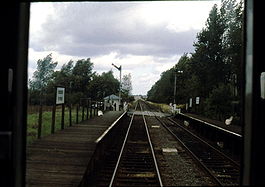Kempston Hardwick railway station
| Kempston Hardwick |
|
|---|---|
 |
|
| Location | |
| Place | Kempston Hardwick |
| Local authority | Bedford |
| Coordinates | 52°05′31″N 0°30′14″W / 52.092°N 0.504°WCoordinates: 52°05′31″N 0°30′14″W / 52.092°N 0.504°W |
| Grid reference | TL025447 |
| Operations | |
| Station code | KMH |
| Managed by | London Midland |
| Number of platforms | 2 |
| DfT category | F2 |
| Live arrivals/departures, station information and onward connections from National Rail Enquiries |
|
| Annual rail passenger usage* | |
| 2011/12 |
|
| 2012/13 |
|
| 2013/14 |
|
| 2014/15 |
|
| 2015/16 |
|
| History | |
| 1905 | Opened as Kempston Hardwick Halt |
| 1 January 1917 | Temporarily closed |
| 5 May 1919 | Reopened |
| 15 July 1968 | Became unstaffed |
| National Rail – UK railway stations | |
| * Annual estimated passenger usage based on sales of tickets in stated financial year(s) which end or originate at Kempston Hardwick from Office of Rail and Road statistics. Methodology may vary year on year. | |
|
|
|
Kempston Hardwick railway station serves the village of Kempston Hardwick in Bedfordshire, England. It is not to be confused with the nearby town of Kempston. The station has two platforms next to a half-barrier level crossing.
Kempston Hardwick is served by London Midland (previously Silverlink), using 1980s built Class 150 and Class 153 DMUs. One service runs each hour in either direction (except Sundays). The running line through this area has been upgraded to enable the speed limit for passenger trains to increase from 40 to 60 mph.
Kempston Hardwick station, in common with others on the Marston Vale Line, is covered by the Marston Vale Community Rail Partnership, which aims to increase use of the line by involving local people.
Kempston Hardwick was one of three halts opened by the London and North Western Railway in 1905 between Stewartby and Bedford. Their opening coincided with the introduction of a steam railmotor on the Varsity Line; the station platform initially consisted of wooden sleepers laid at ground level for a carriage length. All three closed as a wartime economy measure during the First World War and two were closed during Second World War, never to reopen, leaving Kempston Hardwick as the only survivor. Its survival can be attributed to its convenient location for the nearby Eastwood's Brickworks which was served from 1928 by a private siding on the up side of the line.
...
Wikipedia
